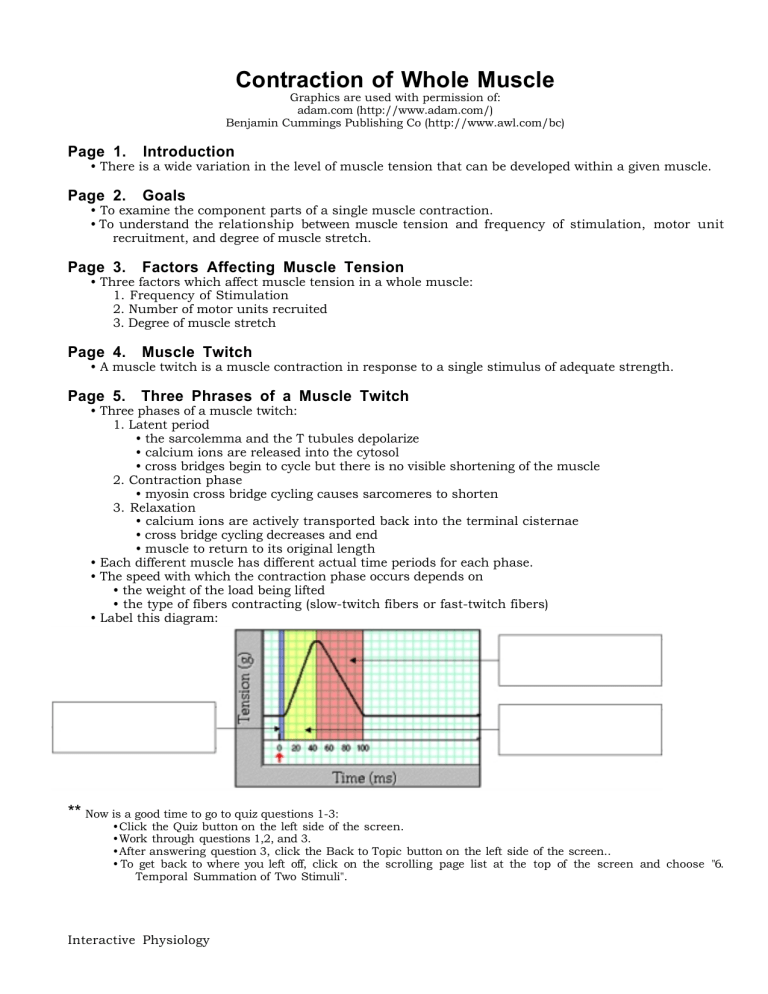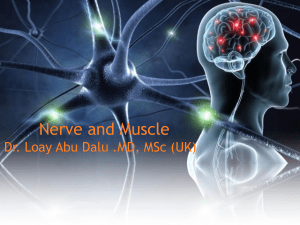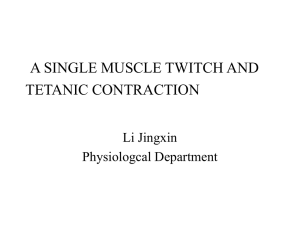Contraction of Whole Muscle

Contraction of Whole Muscle
Graphics are used with permission of: adam.com (http://www.adam.com/)
Benjamin Cummings Publishing Co (http://www.awl.com/bc)
Page 1. Introduction
• There is a wide variation in the level of muscle tension that can be developed within a given muscle.
Page 2. Goals
• To examine the component parts of a single muscle contraction.
• To understand the relationship between muscle tension and frequency of stimulation, motor unit recruitment, and degree of muscle stretch.
Page 3. Factors Affecting Muscle Tension
• Three factors which affect muscle tension in a whole muscle:
1. Frequency of Stimulation
2. Number of motor units recruited
3. Degree of muscle stretch
Page 4. Muscle Twitch
• A muscle twitch is a muscle contraction in response to a single stimulus of adequate strength.
Page 5. Three Phrases of a Muscle Twitch
• Three phases of a muscle twitch:
1. Latent period
• the sarcolemma and the T tubules depolarize
• calcium ions are released into the cytosol
• cross bridges begin to cycle but there is no visible shortening of the muscle
2. Contraction phase
• myosin cross bridge cycling causes sarcomeres to shorten
3. Relaxation
• calcium ions are actively transported back into the terminal cisternae
• cross bridge cycling decreases and end
• muscle to return to its original length
• Each different muscle has different actual time periods for each phase.
• The speed with which the contraction phase occurs depends on
• the weight of the load being lifted
• the type of fibers contracting (slow-twitch fibers or fast-twitch fibers)
• Label this diagram:
**
Now is a good time to go to quiz questions 1-3:
• Click the Quiz button on the left side of the screen.
• Work through questions 1,2, and 3.
• After answering question 3, click the Back to Topic button on the left side of the screen..
• To get back to where you left off, click on the scrolling page list at the top of the screen and choose "6.
Temporal Summation of Two Stimuli".
Interactive Physiology
Page 6. Temporal Summation of Two Stimuli
• Temporal Summation (Wave Summation): Occurs when a second stimulus of the same intensity is applied to a muscle before the completion of the relaxation period of the first stimulus. This results in increased muscle tension.
Page 7. Graph of Temporal Summation
• In temporal summation, the second peak is higher than the first because the additional influx o f calcium ion promotes a second contraction, which is added to the first contraction.
Page 8. Effect of Time Interval on Second Contraction
• How the time interval between stimuli will affect the height of the second contraction:
Page 9. Questions on Effect of Time Interval
• If you wait until relaxation is complete from the first stimulus, then give a second stimulus to the same muscle, temporal summation will not occur.
Page 10. Summation of Multiple Stimuli
• A muscle is repeatedly stimulated with stimuli of equal intensity. A plot is made of muscle tension vs. time. As time proceeds, the interval between stimuli is gradually decreased.
Page 11. Graph of Multiple Stimuli
• Label the five parts to this graph:
Treppe:
• The frequency of stimulation was so slow here that relaxation was complete between contractions. Note that the curve goes down to the baseline after each contraction
• The strength of contraction did increase because muscle contraction causes heat to build up in the muscles and muscles then work better when they are warmer. Enzymes can work faster and more efficiently when a muscle is "warmed up".
Temporal summation:
Interactive Physiology 2
• Now the frequency of stimulation is increased to the point where relaxation cannot totally occur.
• The result is a continual increase in tension which may result from increased availability o f intracellular calcium.
Incomplete tetanus:
• Now the frequency of stimulation is increased to the point where the muscle exhibits even shorter contraction-relaxation cycles, but there is still some degree of relaxation after each contraction.
Complete tetanus:
• When the frequency of stimulation becomes fast enough, the contractions fuse into a smooth, continuous, total contraction with no apparent relaxation.
• This state is due to a continual depositing of calcium ions in the cytosol. As a result, the binding sites on actin continually stay exposed.
Fatigue:
• Tetanus cannot continue forever. With continued rapid stimulation, there is a build-up of acidic compounds which affect protein functioning, a relative but not total lack of ATP, and ionic imbalances resulting from membrane activities. This causes muscle fatigue and the gradual inability of the muscle to respond to stimulation.
**
Note that with treppe, the muscle relaxes after each stimulus. With temporal summation and incomplete tetanus, the muscle never really relaxes totally, and with complete tetanus, the muscle stays contracted. With fatigue, the muscle slowly loses its tension.
**
Now is a good time to go to quiz question 4:
• Click the Quiz button on the left side of the screen.
• Click on the scrolling page list at the top of the screen an d choose "4. Graph of Multiple Stimuli".
• After answering question 4, click the Back to Topic button on the left side of the screen.
• To get back to where you left off, click on the scrolling page list at the top of the screen and choose "12.
Second Fac tor Affecting Muscle Tension".
Page 12. Second Factor Affecting Muscle Tension
• Three factors which affect the development of muscle tension:
1. Frequency of Stimulation
2. Number of Motor Units Recruited
3. Degree of Muscle Stretch
Page 13. Multiple Motor Unit Summation in the Body
• We need to recruit fewer motor units to move a light object compared to a heavy object.
**
Start the animation by clicking on the weight bar that says "80", then place the slider bar on few.
Click the thigh muscle. Then set the slider between few and many and click the thigh again, finally set the slider on "many" and click the muscle. Record your data in the following graph, rating the response as:
0. none
1. required much effort
2. required less effort
3. easy
Number of Motor Units Recruited few intermediate many
80
120
160
200
**
Now is a good time to go to quiz question 5:
• Click the Quiz button on the left side of the screen..
• Click on the scrolling page list at the top of the screen and choose "5. Number of Motor Units".
• After answering question 5, click the Back to Topic button on the left side of the screen.
• To get back to where you left off, click on the scrolling page list at the top of the screen and choose "14. Lab
Simulation of Multiple Motor Unit Summation".
Page 14. Lab Simulation of Multiple Motor Unit Summation
Interactive Physiology 3
• In this animation you set the voltage, then record tension vs. time.
Subthreshold stimulus: A stimulus which does not evoke a visible response. The number of motor units responding is not sufficient to cause visible movement.
Threshold: The minimum stimulus which can evoke a response.
Recruitment: A stronger response than threshold because additional motor units join in to generate an increase in tension.
Maximal stimulus: When all motor units are being recruited and more intense stimulus does not evoke greater tension.
Page 15. Third Factor Affecting Muscle Tension
• Three factors which affect the development of muscle tension:
1. Frequency of Stimulation
2. Number of Motor Units Recruited
3. Degree of Muscle Stretch (length-tension relationship)
Page 16. Length-Tension Relationship
• The strength of a muscle contraction can be altered by changing the starting length of a muscle.
Unstretched Muscle: The overlapping thin filaments from opposite ends of the sarcomere, interfere and conflict with each other.
This restricts productive cross bridge building and less tension develops. The unstretched muscle produces a relatively weak contraction.
Moderately stretched muscle: Maximum tension is developed when there is an optimum overlap of thin and thick filaments so that all cross bridges can participate in the contraction.
Over stretched muscle: The thin filaments are pulled almost to the ends of the thick filaments where little tension can be developed.
Page 17. Summary
• A single muscle twitch is composed of latent, contraction, and relaxation periods.
• Factors that affect muscle tension:
1. The Frequency of Stimulation: increasing the frequency provides temporal summation and increased muscle tension.
2. The Number of Motor Units Recruited: stimulation of more motor units produces increased muscle tension.
3. The starting length of the muscle: Optimum stretch permits maximum binding of cross bridges for maximum muscle tension.
**
Now is a good time to go to quiz questions 6, 7, and 8:
• Click the Quiz button on the left side of the screen.
• Click on the scrolling page list at the top of the screen and choose "6. Thin Filaments at Ends of Thick
Filaments".
• Work through quiz questions 6-8.
Quiz Question #1. Phase of a Muscle Twitch
Interactive Physiology 4
• This question asks you to watch an animation, then predict if it occurs during the latent period, contraction period or relaxation period.
Quiz Question #2. Phase of a Muscle Twitch
• This question asks you to watch an animation, then predict if it occurs during the latent period, contraction period or relaxation period.
Quiz Question #3. Phase of a Muscle Twitch
• This question asks you to watch an animation, then predict if it occurs during the latent period, contraction period or relaxation period.
Quiz Question #4. Graph of Multiple Stimuli
• In this question, you will be asked to identify the parts of a recording of muscle tension vs. time when there are multiple stimuli. The frequency of stimuli to the muscle will increase with time. You will then be asked to match the definitions of treppe, temporal summation, incomplete tetanus, complete tetanus and fatigue.
Quiz Question #5. Number of Motor Units
• This question allows you to predict the number of motor units needed to lift a given object.
• If we lift a light object, but we think it may be heavy, we use too many motor units and we end up applying too much muscle tension for the job.
Quiz Question #6. Thin Filaments at Ends of Thick Filaments
• This question asks you to predict the strength of a muscle contraction, given a diagram of a sarcomere.
Quiz Question #7. Overlapping Thin Filaments
• This question asks you to predict the strength of a muscle contraction, given a diagram of a sarcomere.
Quiz Question #8. Ideal Position of Thin Filaments
• This question asks you to drag the thin filaments to their position within the sarcomere that w i l l provide the ideal starting position for maximum contractile force.
1. (Page 1.) The level of muscle tension that can be developed within a given muscle is always constant.
a. true b. false
2. (Page 3.) What are the three factors which affect muscle tension in a whole muscle?
3. (Page 4.) A muscle contraction in response to a single stimulus of adequate strength is called a
_ _ _ _ _ _ _ _ _ _ _ _ _ _ _ _ _ _ .
4. (Page 5.) What are the three phases of a muscle twitch?
5. (Page 5.) Tell if the following are characteristic of the latent period, contraction period or relaxation period of a muscle twitch.
bridge cycling causes sarcomeres to shorten shortening of the muscle are actively transported back into the terminal cisternae cycling decreases and ends and the T tubules depolarize to its original length
6. (Page 5.) What two factors will cause the speed of the contraction phase of a muscle twitch to vary?
7. (Page 6.) What is it called when a second stimulus of the same intensity is applied to a muscle before the completion of the relaxation period of the first stimulus resulting in increased muscle tension?
Interactive Physiology 5
8. (Page 7.) In temporal summation, why is the second peak is higher than the first?
9. (Page 8.) If two stimuli are given to the same muscle, which will result in a more intense second contraction?
a. If the stimuli are given 50 milliseconds apart b. If the stimuli are given 70 milliseconds apart
10. (Page 9.) If you wait until relaxation is complete from the first stimulus, then give a second stimulus to the same muscle, why won't temporal summation occur?
11. (Page 11.) In which of the following states does the muscle stay contracted, with no apparent relaxation?
a. temporal summation b. fatigue c. incomplete tetanus d. treppe e. complete tetanus
12. (Page 11.) In which of the following states does the muscle relax totally between stimulations?
a. temporal summation b. fatigue c. incomplete tetanus d. treppe e. complete tetanus
13. (Page 11.) In which of the following states does the strength of contraction increase with each stimulation because of a gradual accumulation of calcium ions in the cytosol?
a. temporal summation b. fatigue c. complete tetanus d. treppe
14. (Page 11.) In which of the following states does the strength of contraction decrease with each stimulation?
a. temporal summation b. fatigue c. complete tetanus d. treppe e. incomplete tetanus
15. (Page 11.) Which of these is not a reason for muscle fatigue?
a. ionic imbalances resulting from membrane activities b. relative but not total lack of ATP c. depletion of calcium ions in the cytosol d. a build-up of acidic compounds
16. (Page 12.) Which of these is not a factor which affects the development of muscle tension: a. Number of Motor Units Recruited b. Degree of Muscle Stretch c. Frequency of Stimulation d. they are all factors
17. (Page 13.) A given muscle always uses the same number of motor units, no matter what the muscle is trying to accomplish.
a. true b. false
18. (Page 14.) The minimum stimulus (voltage) which can evoke a response is applied to a muscle. This is called _________.
a. threshold b. a maximal stimulus c. a subthreshold stimulus d. recruitment
Interactive Physiology 6
19. (Page 14.) The stimulus (voltage) is applied to a muscle and there is no visible response. This is called a. threshold b. a maximal stimulus c. a subthreshold stimulus d. recruitment
20. (Page 14.) The stimulus (voltage) is applied to a muscle. When another, more intense stimulus does not evoke greater tension the original stimulus would be called a. a threshold stimulus b. a maximal stimulus c. a subthreshold stimulus d. recruitment
1. False
2. Frequency of stimulation, number of motor units recruited, and degree of muscle stretch.
3. Muscle twitch
4. Latent period, contraction period and relaxation period.
5. Latent period: b,e contraction period: a relaxation period: c,d,f
6. The weight of the load being lifted and the type of fibers contracting (slow-twitch fibers or fast-twitch fibers).
7. Temporal Summation
8. Because the additional influx of calcium ion promotes a second contraction, which is added to the first
9. a
10. Calcium ions from the first contraction have already been actively transported back into the terminal cisternae. Cross bridge cycling has stopped and there is no activity to be summed.
11. e 14. b 18. a
12. d
13. a
15. c
16. d
19. c
20. b
17. b
Interactive Physiology 7






